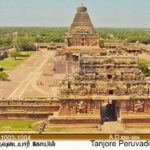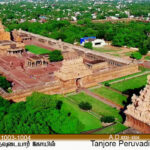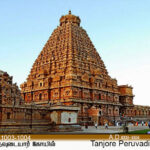

Tamil Architecture

Tamil Architecture
Tamils have defined their region of living according to its geography, climatic conditions and natural resources, namely Kurinji (Mountains), Mullai (Forests), Marutham (Agricultures lands), Neithal (Regions in and around sea/ocean) and Palai (Desert condition) and constructed and equipped their buildings and houses in relations to the available sources within their regions.
According to U.V. Saminatha Iyer (a great scholar and researcher of tamil literature), noted down the wide choices and formulations of tamil architecture, evident through sangam literature. Nedunelvadai, one of the sangam literatures, explained in detail about the theories and implementation strategies of 2000 year old tamils in the construction of houses, palaces and commercial buildings.
Paripatal, another sangam literature poem, explained the construction and operation of wastewater flow management system, making it more surprising in tamil history, since those systems were used 2000 years ago from now.
Dam constructed 2000 years ago!
Kallanai (also known as the Grand Anicut) is an ancient dam. It is built (in running water) across the Kaveri river flowing from Tiruchirapalli District to Thanjavur district. The dam located in Tiruchirappalli District Located at a distance of 45 km from Thanjavur, 15 km from Tiruchirappalli, the dam was originally constructed during the reign of Chola king Karikalan in c. 100 BC – c. 100 AD. It is the fourth oldest water diversion or water-regulator structures in the world and the oldest in India that is still in use. Because of its spectacular architecture, it is one of the prime tourist spots in Tamil Nadu.
The dam was originally built by King Karikalan of the Chola Dynasty in c. 100 BC – c. 100 AD. It is located on the River in Tiruchirappalli District, approximately 15km from the city of Tiruchirappalli and 45km from the city of Thanjavur. The idea behind the construction of the dam was to divert the river to the delta districts thereby boosting irrigation. This dam was re-modeled by the British during the 19th century. In 1804, Captain Caldwell, a military engineer, was appointed by the British to make a study on the Kaveri river and promote irrigation for the delta region. He found that a large amount of water passed onto the Kollidam leaving behind a small volume for irrigation purposes. Caldwell initially proposed a solution by raising the dam and hence raised the dam stones to a height of 69 centimetres (27 in), thus increasing the capacity of the dam. Following this, Major Sim proposed the idea of undersluices across the river with outlets leading to the Kollidam River (Coleroon) thus preventing formation of silt. The Lower Anaicut built by Sir Arthur Cotton in the 19th century CE across Coleroon, the major tributary of Cauvery, is said to be a replicated structure of Kallanai.
Temple, constructed 1000 years ago!
The Peruvudaiyar Temple also known as Rajarajeswaram , ( Big Temple) at Thanjavur, is the world’s first complete granite temple and a brilliant example of the major heights achieved by Cholas in temple architecture, built between A.D. 1003 – 1010. It is a tribute and a reflection of the power of its patron RajaRaja Chola I. It remains as one of the greatest glories of Indian architecture. The temple is part of the UNESCO World Heritage Site “Great Living Chola Temples”.
This temple is one of India’s most prized architectural sites. The temple stands amidst fortified walls that were probably added in the 16th century. The ‘Vimana’ – or the temple tower – is 216 ft (66 m) high (about 70 meters) and is among the tallest of its kind in the world. The Kalash or ‘Shikhara’ of the temple is of monolithic granite weighing 81.25 tons. There is a big statue of Nandi (sacred bull), carved out of a single rock, at the entrance measuring about 16 feet long and 13 feet high . The entire temple structure is made out of hard granite stones, a material sparsely available currently in Thanjavur area where the temple is located.


